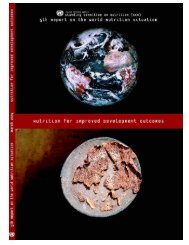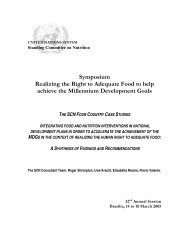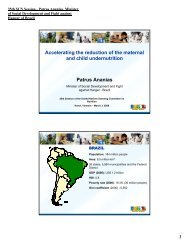8FEATURESSCN NEWS # 35 back to contentswww.unsystem.org/scndeveloping countries had large scale iodization programmes and it was estimated that less than 30% of saltwas iodized (Dalmiya et al 2004). This has changed following the adoption of the policy of <strong>Universal</strong> <strong>Salt</strong><strong>Iodization</strong> (<strong>USI</strong>) by the Joint UNICEF/WHO Committee on Health Policy (1994). <strong>USI</strong> requires that all foodgrade salt for human and animal consumption be iodized (WHO/UNICEF/ICCIDD 1996). This requireslegislation. However, appropriate legislation did not always follow. The recommended level is 20-40mg iodineper kilo of salt. The addition of this amount of potassium iodate can be made with a greatly reduced saltintake if necessary.The global partnershipAn extended informal global partnership has developed over the years. This partnership includes the people,governments and salt industry of IDD affected countries; the international agencies WHO and UNICEF, theWorld Bank, the bilateral aid agencies and the technical agencies; the ICCIDD, MI, PAMM (Program AgainstMicronutrient Malnutrition, now Emory University), the salt industry and Kiwanis International. Theestablishment of the Network for the Sustained Elimination of Iodine Deficiency is described by Gautam andby de Jong in this issue of the SCN News.Development of national programmesA significant factor in the development of national programmes between 1987 and 1998 has been a successionof annual regional meetings held throughout the world over 20 years by the ICCIDD with the collaborationof WHO and UNICEF. These meetings have been attended by representatives from Ministries of Healthand other important sectors such as theFigure 1: Wheel Model for IDD Elimination Programmesalt industry and media in relation to thenational programmes.It is through these regional meetings forreview of national programmes that thelimited number of experts from theICCIDD network have been able to communicatewith professionals from manycountries. This has subsequently led toconsultancies and further contacts designedto identify and subsequently removeobstacles to progress. The expertiserequired includes epidemiology, theestablishment of laboratories (salt iodine,urine iodine), advice regarding planning,education and communication, management,iodized salt and other iodine technologies.This is why the ICCIDD multidisciplinarynetwork has been developedto assist countries.A series of WHO/UNICEF/ICCIDDRegional Reports (covering all regions)have been published. Notable progresshas occurred in Africa. At the first AfricanRegional meeting (Yaounde, Cameroonin 1987), only 22 countries wererepresented. At this time an IDD TaskForce for Africa was established by theICCIDD with WHO and UNICEF to1. Assessment of the situation requires baseline IDD prevalence surveys,including measurement of urinary iodine levels and an analysis of the salteconomy. 2. Communication of findings to health professionals and thepublic, so that there is full understanding of the IDD problem and the potentialbenefits of elimination of this most common preventable cause of braindamage. A community education campaign is required to educate all agegroups about the effects of iodine deficiency with particular emphasis on thebrain. 3. Development of a plan of action includes the establishment of anintersectoral committee or coalition on IDD and the formulation of a strategydocument on achieving the elimination of IDD. 4. Achieving political willrequires intensive education and lobbying of politicians and other opinionleaders. 5. Implementation needs the full involvement of the salt industry.Special measures, such as negotiations for monitoring and quality control ofimported iodized salt, are required. It will also be necessary to ensure thatiodized salt delivery systems reach all affected populations, including theneediest. In addition, the establishment of cooperatives for small producers,or restructuring to larger units of production, may be needed. Implementationwill require training at all levels in management, salt technology, laboratorymethods and communication. 6. Monitoring and evaluation require theestablishment of an efficient system for the collection of relevant scientificdata on salt iodine content and urinary iodine levels. This includes theestablishment and the maintenance of suitable laboratory facilities.
www.unsystem.org/scn FEATURES 9promote national programmes. In 1996, 45 countries were represented including Angola, Eritrea,Mozambique and Republic of the Congo in spite of the occurrence of civil war in these countries. There hasbeen significant progress in country programmes in Africa since 1987, including the Republic of the Congo.The Social Process ModelAt these regional meetings a ‘wheel’ feed back model for a national programme has been presented to showthe social process involved, as shown in Figure 1 (Hetzel 1988). The model shows the diversity of functionsthat have to be linked together to achieve an integrated successful national IDD elimination programme, andinvolves six components clockwise in the hub of the wheel.Three key elements in the Social Process Modelare: a national intersectoral coordinating body, commission or coalition; a plan of action for the elimination ofIDD; and legislation on salt iodization. The ‘wheel’ model is driven by the ‘marker’ of salt iodine consumptionand the urine iodine excretion of the community or population. Urinary iodine excretion provides an excellentindication of iodine intake, and can be easily assessed using the median level from a sample of just 40subjects from each local community. These markers have provided the essential elements for monitoring theprogramme to assess whether iodine deficiency is being eliminated. Determinations should be carried outregularly every year. If there is evidence of inadequacy of iodine intake through iodized salt then appropriatemeasures can be taken at factory, retail or household level.Measurements of urinary iodine have usually been carried out in children aged 8-12 years taking advantageof their availability in the school setting. However, if school attendance is reduced (through distance orpoverty) then this must be followed up by sampling at the household level.Another community group of great importance to the elimination programme are women of reproductive age,particularly including pregnant and breastfeeding women. These groups should receive special attention, forexample as has been done in China where comprehensive data are now being collected.The availability of the salt iodine and urine iodine determinations suitable for large-scale use is a greatstrength for the National IDD EliminationProgramme. The effectiveness ofTable 3: WHO/ICCIDD/UNICEF criteria for monitoringprogress towards eliminating IDD as a public health problem*the social process can be reliably and IndicatorGoalreadily assessed through these determinations.Adequate resources Percentage of households consuming effectively iodized salt >90%1. <strong>Salt</strong> iodizationmust be provided for iodine measurementsby funding trained manpower, Proportion below 100µg/L







